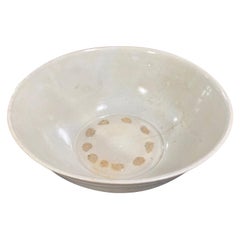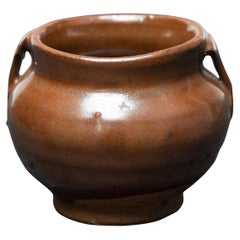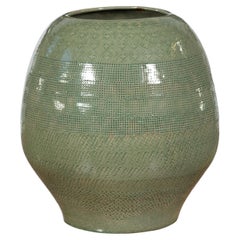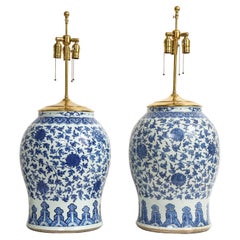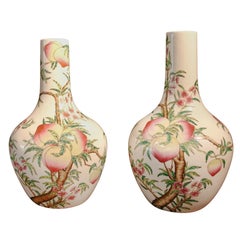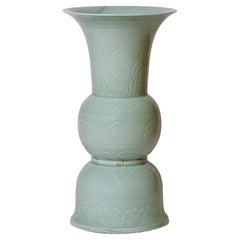Continental US - Ceramics
to
255
1,981
1,982
1,348
1,882
94
5
58
22
13
12
5
4
4
2
2
2
1
1
1
1
331
581
970
99
352
231
121
38
4
12
16
5
9
15
12
9
5
1,930
985
145
111
107
1,803
1,605
988
510
116
1,981
1,981
1,981
27
16
14
13
10
Item Ships From: Continental US
Korean Joseon Dynasty White Glazed Pottery Ceramic Chawan Tea Bowl
Located in Studio City, CA
A wonderful Joseon Dynasty (1392-1897) Korean pottery bowl - perhaps a monk's Chawan tea bowl. The work features a beautiful white glaze, wonderful organic shape, engaging design and...
Category
19th Century Korean Antique Continental US - Ceramics
Materials
Ceramic, Earthenware, Pottery
Petite Chinese Glazed Apothecary Jar, c. 1900
Located in Chicago, IL
This petite glazed jar from China's Shanxi province exemplifies the timeless appeal of handcrafted pottery. Once used in an apothecary to hold ground herbs and oils for traditional m...
Category
Early 20th Century Chinese Qing Continental US - Ceramics
Materials
Ceramic
Large Green Glazed Ceramic Vase with Incised Geometric Bands
Located in Yonkers, NY
This large ceramic vase draws attention with its generous proportions, soft green glaze, and finely incised surface patterns. The rounded form rises gently from a narrow base and swe...
Category
Late 20th Century Thai Continental US - Ceramics
Materials
Ceramic
Pair of 19th Century Qing Dynasty Chinese Blue and White Vases Turned to Lamps
Located in New York, NY
A Magnificent and Large Pair of 19th Century Qing Dynasty Chinese blue and white porcelain vases mounted as lamps. Each i...
Category
19th Century Chinese Antique Continental US - Ceramics
Materials
Porcelain
Pair of Famille Rose "Peaches" Bottle Vases 'Tianquiping'
Located in Austin, TX
A fine pair of Chinese porcelain "peaches" bottle vases (tianquiping) from the late Qing Dynasty or early Republic period.
Well potted and of elegant form, the straight cylindrica...
Category
Early 20th Century Chinese Continental US - Ceramics
Materials
Porcelain
Carved Celadon Porcelain Altar Vase
By Bo Jia for Middle Kingdom
Located in Manassas Park, VA
This carved trumpet vase is a traditional porcelain vessel from Jingdezhen, a town long distinguished by imperial patronage. This piece is a porcelain vase with a design reminiscent of an ancient Chinese altar piece...
Category
20th Century Chinese Qing Continental US - Ceramics
Materials
Porcelain
Late 19th Early 20th Century Japanese, Meiji Satsuma Vase Double Gourd Shape
Located in New York, NY
Late 19th / early 20th century Japanese, Meiji Satsuma vase with a double gourd form. The design incorporates underwater plants with golden Koi Car...
Category
Late 19th Century Japanese Meiji Antique Continental US - Ceramics
Materials
Ceramic
Petite Chinese Glazed Apothecary Jar, c. 1900
Located in Chicago, IL
This petite glazed jar from China's Shanxi province exemplifies the timeless appeal of handcrafted pottery. Once used in an apothecary to hold ground herbs and oils for traditional m...
Category
Early 20th Century Chinese Qing Continental US - Ceramics
Materials
Ceramic
Chinese Porcelain Jardiniere / Fish Bowl
Located in Dallas, TX
Antique Chinese Famille Verte Porcelain Jarniniere / Fish bowl featuring hand painted butterfly and floral details on a pale green background. Very good antique condition with no maj...
Category
Late 19th Century Chinese Other Antique Continental US - Ceramics
Materials
Porcelain, Paint
Pair of Chinese Famille Rose Butterfly & Gourd Containers, c. 1920
Located in Chicago, IL
Used to store loose leaf tea, these small porcelain jars are decorated in a style of overglaze enameling known as "famille rose." Sometimes referred to as "yangcai" or "foreign color...
Category
Early 20th Century Chinese Chinese Export Continental US - Ceramics
Materials
Porcelain
Three 18th Century Chinese Export Plates
Located in Buchanan, MI
Set of three Chinese export plates with floral decoration. Three 18th century Chinese exprort plates.
Category
18th Century and Earlier Chinese Chinese Export Antique Continental US - Ceramics
Materials
Porcelain
$2,400 / set
Chinese Blue and White Covered Ginger Jar
Located in East Hampton, NY
Chinese blue and white covered ginger jar.
Category
Early 20th Century Chinese Continental US - Ceramics
Materials
Ceramic
Pair of Imari Sleeve Vases
Located in Hudson, NY
with elegantly carved wooden stand. Designs featuring floral patterns and birds.
Category
Late 19th Century Japanese Antique Continental US - Ceramics
Materials
Wood
$15,000 / item
Chinese Blue and White Tea Leaf Jar
Located in Chicago, IL
Designed to store tea leaves, this jar is nonetheless a stunning example of blue and white porcelain. Surrounded by peonies and chrysanthemum blossoms, two phoenixes sit perched upon...
Category
21st Century and Contemporary Chinese Continental US - Ceramics
Materials
Porcelain
Chinese Blue and White Porcelain Shallow Bowl
Located in Astoria, NY
Chinese Blue and White Porcelain Shallow Bowl, with floral and vine motif. 1.5" H x 7.75" Diameter. Provenance: From an Upper East Side Collection.
Category
Early 20th Century Chinese Qing Continental US - Ceramics
Materials
Porcelain
Pair Vintage Chinese Famille Rose Porcelain Vases in Qianlong Style
Located in New York, NY
Pair of vintage Chinese vases decorated with raised motifs including flowers, ornaments such as vases and vessels, on a light grey crackl...
Category
20th Century Chinese Continental US - Ceramics
Materials
Porcelain
Antique Stoneware Small Green-Glazed Mataban Jar
Located in Chicago, IL
Antique Stoneware Small Green-Glazed Mataban Jar / Vase
This large antique Chinese vase/jar has six small carved handles around the rim. It...
Category
19th Century Chinese Ming Antique Continental US - Ceramics
Materials
Stoneware
Antique Chinese Export Porcelain Vase with Flowers
Located in Philadelphia, PA
A fine Chinese Export porcelain vase.
With an off-white ground decorated with painted flowers throughout (chrysanthemums & daisies?)
The rim with a light orange border, and both ri...
Category
20th Century Chinese Chinese Export Continental US - Ceramics
Materials
Porcelain
Chinese Export Blue and White Leaf Shaped Dish, Qianlong, Mid 18th Century
Located in Austin, TX
A fine and unusual Chinese Export blue and white decorated porcelain leaf-shaped dish or charger, Qianlong Period, mid 18th century, circa 1760, China.
The dish or charger of intriguing leaf-shaped form, with serated edges, and set upon a short foot. The shape seemingly based on a Meissen design.
The porcelain decorated with a courting scene of a couple in a garden setting. They are surrounded by flowering bushes and trees. Butterflies draw nectar from the flowers, while dragonflies flit above. In the foreground are a pair of very plump quail.
Decorated in underglaze blue enamel on a white ground, the blue and white decoration actually is based an Kakiemon pattern of the same period.
So in short, we have a Chinese porcelain piece based on a German Meissen form...
Category
1760s Chinese Chinese Export Antique Continental US - Ceramics
Materials
Porcelain
Chinese Celadon Porcelain Vases, Republican Period
Located in New York, NY
metal bases shown in pictures are included with these items; celadon glazed, crackle decorated vases; each porcelain vase on fitted bronze base; approximate measurements of each vase...
Category
Early 20th Century Chinese Continental US - Ceramics
Materials
Porcelain
Chinese Hokkien Style Ceramic Roof Tile Fragment, Nicely Mounted
Located in Milford, NH
A fine Chinese Hokkien style polychrome ceramic roof tile fragment of a warrior on a dragon with metal spear, nicely mounted to a custom solid acrylic stand. Probably dates to the ea...
Category
20th Century Chinese Continental US - Ceramics
Materials
Ceramic
Pair of Antique Chinese Export Porcelain Vases with English Coats of Arms
Located in New York, NY
A pair of fine Chinese export porcelain two handled vases in blue white and red brick colors, made for the English market with royal coat...
Category
19th Century Chinese George II Antique Continental US - Ceramics
Materials
Porcelain
Chinese Ginger Jar with Foo Dog Topper
Located in Dallas, TX
This large 1950s Chinese ginger jar is made of many bright, contrasting and vibrant colors. The cover of the jar has a foo dog on top of it adding some authentic Chinese decoration.
Category
1950s Chinese Vintage Continental US - Ceramics
Materials
Porcelain
Korean Reticulated Celadon Brush Holder Joseon Dynasty
Located in Atlanta, GA
A Korean porcelain brush holder in cylinder log form from the end of Joseon dynasty circa late 19th century. Cherished by the scholars, brush pot like this would grace the desk in th...
Category
Late 19th Century Korean Other Antique Continental US - Ceramics
Materials
Ceramic
Nine 19th Century Chinese Export Spinach and Egg Bowls
Located in Palm Beach, FL
Fine and rare set of five "egg and spinach" Chinese export porcelain bowls. Painted in a Tang Sancai or "Tiger Skin" technique used in the Kangxi perio...
Category
19th Century Chinese Chinese Export Antique Continental US - Ceramics
Materials
Glass
Pair of Taisho Period Japanese Satsuma Style Covered Jars
Located in Miami, FL
Pair of 19th century temple jars, lidded, Chinoiserie Foo Dog Finials, Exceptional quality and detail with raised hand painted work.
Category
Late 19th Century Chinese Chinoiserie Antique Continental US - Ceramics
Materials
Ceramic
Canton Famille Rose Large Baluster Vase, Qing Dynasty, Ca. 1840
Located in Banner Elk, NC
A large Canton Famille rose baluster vase, of baluster form, with a tall waisted neck, an everted scalloped rim, the neck and shoulders with applied paired confronting Foo lions and ...
Category
19th Century Chinese Chinese Export Antique Continental US - Ceramics
Materials
Porcelain
Antique Chinese Ceramic Tea Leaf Storage Jar Song-Yuan Dynasty
Located in Atlanta, GA
A stoneware pottery jar used for storage, made in southern China Fujian or Guangdong province since Song Dynasty for domestic use as well as export. They were widely exported to Japa...
Category
15th Century and Earlier Chinese Archaistic Antique Continental US - Ceramics
Materials
Ceramic
Set of Five Chinese Sancai Female Attendant Figures
Located in Chicago, IL
Molded of earthenware, this set of five petite sculptures are a type of centuries-old burial figurine known as míngqì. Such model figures were placed in tombs of individuals with high status to ensure a safe journey to the afterlife. Meant to depict the pleasures of daily life, common burial figures...
Category
15th Century and Earlier Chinese Antique Continental US - Ceramics
Materials
Ceramic
Pair of Chinese Export Porcelain and French Bronze Candelabra
Located in Dallas, TX
A pair of candelabra consisting of a pair of 18th century Chinese export vases mounted in 19th century French bronze in the Louis XVI style. The porcelains are very decorative and do...
Category
Late 19th Century French Chinese Export Antique Continental US - Ceramics
Materials
Bronze
Ceramic Vase with Bespoken Glaze by Makoto Yabe
By Makoto Yabe
Located in Atlanta, GA
Made by Japanese ceramic artist Makoto Yabe (1947-2005), this stoneware vase features a globular body supported by a round pedestal foot. A similarly shaped neck extends to a rimmed mouth opening. Robust in form with thick wall, the vase is noted for its irregular cloved form. The surface is covered in a beige-yellow glaze, on top of which, dark brown strokes and thick white feldspar slip were artistically applied in a splashed and washed pattern. Together with some random shallow incision lines, they form an abstract painting with textured surface where some slip forms small droplets at the end of the stroke. The work was created in traditional Japanese manner and reflects the beauty of Wabi Sabi, a Zen aesthetic for the imperfect perfection.
The base was incised with the artist's cipher.
"Makoto Yabe's work beautifully exemplifies the transmission of Japanese ceramics to the West. Born in Fukushima, Japan, Yabe began studying ceramics in Kyoto at the age of nine. He completed his training at the age of 24, with a four-year apprenticeship under Jinmatsu Uno and Sango Uno. Yabe then came to Boston, where he was an integral member of the local ceramic community, yet he maintained his Japanese roots. As an instructor of ceramics, Yabe worked in the Boston area at numerous schools and universities, touching the lives of all his students and expanding their knowledge and appreciation of studio ceramics."
Biography sited from Pucker Gallery...
Category
Late 20th Century American Organic Modern Continental US - Ceramics
Materials
Ceramic, Stoneware
Chinese Blue & White Jar with Birds & Flowers
Located in Chicago, IL
Loosely brushed with cobalt blue pigments, this round blue-and-white storage jar is adorned with a ribbon-tailed bird perched on a cluster of rocks, a symbol for a long and happy lif...
Category
21st Century and Contemporary Chinese Qing Continental US - Ceramics
Materials
Porcelain
Japanese Kutani Pheasant Sculpture, Okimono, Showa Era, Early 20th Century
Located in Austin, TX
A spectacularly glazed Japanese Kutani model, okimono, of a pheasant, Showa era, early 20th century, Japan.
The okimono, or decorative sculpture, in the form of a magnificent phea...
Category
1930s Japanese Showa Vintage Continental US - Ceramics
Materials
Porcelain
Chinese Famille Rose Porcelain Vase
Located in Bradenton, FL
Chinese Famille Rose porcelain vase. Decorated with birds, flowers, and figures of the era with gold figures on neck and gold trim. Chinese signature mar...
Category
Early 20th Century Chinese Chinese Export Continental US - Ceramics
Materials
Ceramic
Vintage Chinese Blue and White Porcelain Baluster Form Vase
Located in Doylestown, PA
Blue and white baluster form porcelain vase with Zhongfeng mark on base, c. 1960s.
Beautiful vase with a sweeping mountainous scene and unique calligraphy script. A unique Chinese p...
Category
1960s Chinese Ming Vintage Continental US - Ceramics
Materials
Porcelain
Pair of French Ormolu Mounted Chinese Celadon Crackle Porcelain Covered Vases
Located in New York, NY
Pair of 19th C French Ormolu Mounted Chinese Celadon Crackle Porcelain Covered Vases. Each vase has a rounded ovoid form with a domed lid and a finial in the shape of a stylized flo...
Category
1880s French Louis XIV Antique Continental US - Ceramics
Materials
Bronze
Chinese Phoenix Motif Blue & White Porcelain Vase
Located in Astoria, NY
Chinese Phoenix Motif Blue and White Glazed Porcelain Vase, together with carved hardwood stand. Vase: 14" H x 8.5" Diameter. Provenance: From the Upper East Side Apartment of a For...
Category
Late 19th Century Chinese Antique Continental US - Ceramics
Materials
Porcelain
$1,450 Sale Price
38% Off
Pair of Chinese Persimmon Fantail Vases with Children at Play, c. 1920
Located in Chicago, IL
This early 20th century porcelain vase is sculpted to a classic Chinese phoenix-tail form and decorated with persimmon-orange enamel and several cartouche paintings of picturesque sc...
Category
Early 20th Century Chinese Art Deco Continental US - Ceramics
Materials
Porcelain
Two Islamic Nishapur Glazed Pottery Bowls
Located in Atlanta, GA
A collection of two small pottery bowls with polychrome central figurative decorations, matching size and similar conical form. These bowls are identified as Nishapur ware circa 10th century (in nowadays Iran). They were stoneware (possibly buffware) and covered with opaque white glaze. Both were lovely decorated with a central human figure within an outer border. One is predominantly yellow, an imitation of luster ware...
Category
15th Century and Earlier Persian Islamic Antique Continental US - Ceramics
Materials
Ceramic
$3,600 / item
Ceramic Famille Rose Chinoiserie Jar or Urn Lid
Located in Oklahoma City, OK
A round ceramic famille rose bottle or urn lid. Although the base of this piece is missing, we love the idea of hanging it on a wall as a decorative chinoiseri...
Category
20th Century Chinese Chinoiserie Continental US - Ceramics
Materials
Ceramic, Paint
$80 Sale Price
20% Off
Pair of Chinese Phoenix Tail Vases with Birds & Flowers, c. 1924
Located in Chicago, IL
Sculpted to a traditional Chinese phoenix tail vase form, these elegant early 20th-century vases are adorned with charming scenes of birds & flowers. Brushed with famille rose enamel...
Category
Early 20th Century Chinese Qing Continental US - Ceramics
Materials
Porcelain
A Beautiful Chinese Celadon Crackle Ge Ware Bowl or Centerpiece
Located in New York, NY
A Beautiful Chinese Celadon Crackle Ge Ware Bowl. The bowl showcases the distinctive crackled glaze characteristic of Ge ware. The bowl features a pale greyish-ivory glaze with a ne...
Category
Early 1900s Chinese Qing Antique Continental US - Ceramics
Materials
Porcelain
Large Japanese Imari Charger, Edo/Meiji Period, mid 19th century, Japan
Located in Austin, TX
A large 18.25" diameter Japanese Imari porcelain charger, Edo to Meiji Period, mid 19th century, Japan.
The large charger of near flattened form and decorated in the typical Imari palette of underglaze blue with red, orange and green overglaze enamels and gilt highlights.
The design is centered on a roundel with a dense design of scrolling peony blossoms and leaves in underglaze blue. Two large pictorial reserves of Shinto priests...
Category
Mid-19th Century Japanese Meiji Antique Continental US - Ceramics
Materials
Porcelain
Large Kutani Million Faces Porcelain Platter 19th Century
Located in Lambertville, NJ
Large 15" in diameter Kutani Million Faces Porcelain Platter 19th Century. Age appropriate condition with a mark on the foot and some crazing from age.
Category
19th Century Chinese Antique Continental US - Ceramics
Materials
Porcelain
Korean Ceramic Storage Jar Joseon Dynasty
Located in Atlanta, GA
A Korean ceramic storage jar circa 18th century of Joseon Dynasty. The jar is of a characteristic form with a bulbous upper body that tappers with a gra...
Category
18th Century Korean Other Antique Continental US - Ceramics
Materials
Ceramic
Korean Ceramic Tea Bowl with Slip Inlays Goryeo Dynasty
Located in Atlanta, GA
A small ceramic conical form tea bowl from Korean Goryeo Dynasty circa 14th century. The bowl is of a slightly irregular shape and covered in a grayish overglaze. The inlaid slip dec...
Category
15th Century and Earlier Korean Archaistic Antique Continental US - Ceramics
Materials
Ceramic
Fine Chinese Blue and White Porcelain Spoon, c. 1850
Located in Chicago, IL
A delicate example of the time-honored practice of blue-and-white ceramics, this 19th century porcelain soup spoon was likely used as an everyday ...
Category
Mid-19th Century Chinese Qing Antique Continental US - Ceramics
Materials
Porcelain
Chinese Archaistic Bronze Tripod Censer, late Qing Dynasty, c 1900, China
Located in Austin, TX
A small and well cast Chinese archaistic bronze tripod incense burner, censer, late Qing Dynasty, circa 1900, China.
The small censer features a squat and bulbous body, very short n...
Category
Early 1900s Chinese Qing Antique Continental US - Ceramics
Materials
Bronze
Antique Korean Celadon Bottle Vase Joseon Dynasty
Located in Atlanta, GA
A Korean ceramic bottle-form vase circa 16th century Joseon Dynasty. It was likely intended as a wine bottle, the pear-shaped vessel with flaring neck feature a celadon glaze exterio...
Category
16th Century Korean Archaistic Antique Continental US - Ceramics
Materials
Ceramic
Pair Antique Japanese Imari Porcelain Vases with Reticulated Pierce Work Ca 1880
Located in New Orleans, LA
Pair Antique Japanese Imari Porcelain vases with Reticulated Pierce Work, Circa 1880-1890.
Category
19th Century Japanese Antique Continental US - Ceramics
Materials
Porcelain
Nanking Crackle Glazed Dragon Charger, 19th Century
Located in Savannah, GA
A Nanking crackle glazed dragon charger, 19th century.
16 inches wide by 3 inches tall
Category
19th Century Antique Continental US - Ceramics
Materials
Porcelain
Large 19th Century Hand Painted Imari Porcelain Vase Meiji Period
Located in Lambertville, NJ
A remarkable hand painted Japanese porcelain Imari vase. Classic iron red and cobalt blue on a white porcelain background. Elegant Japanese figures painted all around the center port...
Category
1880s Meiji Antique Continental US - Ceramics
Materials
Porcelain
Han Dynasty Green Glazed Archers Watch Tower Oxford TL Tested
Located in Dallas, TX
Monumental Pottery Watch Tower in Green Glaze; Han Dynasty (2016 BC -AD 220)
Earthenware three-storied pavilion from the Eastern Han Dynasty. Each of the...
Category
15th Century and Earlier Chinese Han Antique Continental US - Ceramics
Materials
Terracotta
Mid-century Italian Ceramic Box by Raymor c.1960
By Raymor
Located in San Francisco, CA
ABOUT
A mid-century ceramic glazed jewelry or trinket box. Marked "Italy" underneath.
CREATOR Attributed to Raymor, Italy.
DATE OF MANUFACTURE 1960.
MATERIALS AND TECHN...
Category
Mid-20th Century Italian Mid-Century Modern Continental US - Ceramics
Materials
Ceramic
Blue-Glazed Porcelain Box from Hatcher Collection
Located in Atlanta, GA
17th century Chinese porcelain blue-glazed circular pill box from the Hatcher Collection, painted in different tones of blue with a central prunus flower on a wave pattern ground tha...
Category
17th Century Chinese Antique Continental US - Ceramics
Materials
Porcelain
Extra Large Chinese Canton Blue and White Oval Platter
Located in San Francisco, CA
Extra large Chinese Canton blue and white oval platter. 20.5" X 18" Good depth of 2.25" circa 1900. Very good antique condition.
An exce...
Category
1890s Chinese Chinese Export Antique Continental US - Ceramics
Materials
Porcelain
Oxblood Red Glazed Chinese Melon Jar
Located in Chicago, IL
The melon shape is respected by the Chinese not only as a form but as a symbol for proliferation. These contemporary ceramics call back to the Song Dynasty (960 to 1279) when artisan...
Category
21st Century and Contemporary Chinese Chinese Export Continental US - Ceramics
Materials
Porcelain
$680 / item
Pair Chinese Porcelain Rouleau Shape Famille Vert Imperial Subject Vases, 1800s
Located in New York, NY
A Pair of Chinese Porcelain Rouleau Form Famille Vert Imperial Subject Vases, 1800s
Step into the realm of Chinese porcelain mastery with this captivating pair of Chinese Porcelain Rouleau Form Famille Vert Imperial Subject Vases. These remarkable vases transport you to a world where art and storytelling intertwine, inviting you to embark on a visual journey through vibrant landscapes and captivating narratives.
The artistry of these vases is truly enchanting. Hand-painted scenes unfold before your eyes, depicting majestic mountains, fresh green pine trees, and figures with expressions that evoke a sense of wonder. The resplendent and colorful robes add a touch of elegance to the composition with colors ranging from rich red and emerald green to mesmerizing blue, aqua, and chartreuse hues, creating a harmonious palette that captivates the senses.
The middle of the chimney-shaped vase-necks showcase a hand painted...
Category
1870s Chinese Qing Antique Continental US - Ceramics
Materials
Porcelain
A Pair of Antique Vibrant Blue Chines Porcelain Jars with Wood Lids
Located in Lambertville, NJ
An antique pair of hand painted Chinese porcelain ginger jars with carved hardwood lids. The vibrant blue background with white cartouches on the back and fronts with hand painted f...
Category
Late 19th Century Chinese Chinese Export Antique Continental US - Ceramics
Materials
Porcelain, Hardwood
Antique Korean Ceramic White Bowl Joseon Dynasty
Located in Atlanta, GA
A Korean ceramic bowl covered in a white glaze with a hint of bluish green circa 18th century, possibly earlier of the Joseon Dynasty. The deep bowl fea...
Category
18th Century Korean Archaistic Antique Continental US - Ceramics
Materials
Ceramic
Recently Viewed
View AllMore Ways To Browse
Japanese Oni
Porcelain Censer
Japanese Hirado
Japanese Satsuma Bowl
Japanese Shi Shi
Mashiko Pottery
Japanese Imari Box
Nabeshima Porcelain
Nanking Porcelain
Japanese Ceramic Sake Bottle
Japanese Kutani Early 20th Century
Oribe Ceramics
Porcelain Japanese Statues
Hirado Porcelain
Japanese Bizen Ware Pottery
Japanese Kutani Figure
Ko Kutani
Kutani Figure
